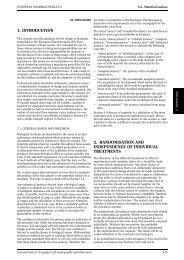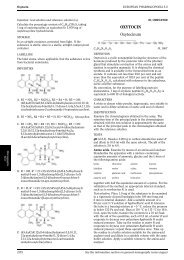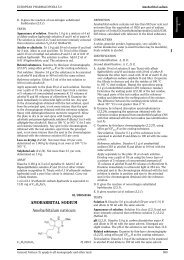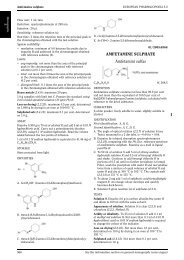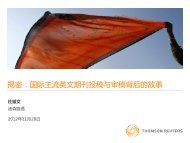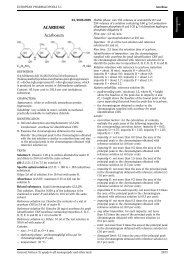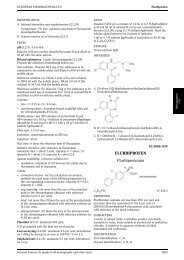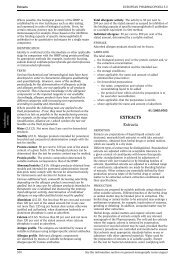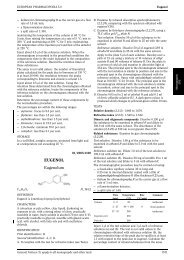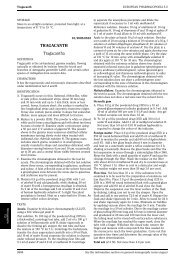PIPERACILLIN Piperacillinum
PIPERACILLIN Piperacillinum
PIPERACILLIN Piperacillinum
You also want an ePaper? Increase the reach of your titles
YUMPU automatically turns print PDFs into web optimized ePapers that Google loves.
Piperacillin EUROPEAN PHARMACOPOEIA 5.0<br />
DEFINITION<br />
8-Ethyl-5-oxo-2-(piperazin-1-yl)-5,8-dihydropyrido[2,3d]pyrimidine-6-carboxylic<br />
acid trihydrate.<br />
Content: 98.5 per cent to 101.0 per cent (dried substance).<br />
CHARACTERS<br />
Appearance: pale yellow or yellow, crystalline powder.<br />
Solubility: very slightly soluble in water. It dissolves in<br />
dilute solutions of acids and of alkali hydroxides.<br />
IDENTIFICATION<br />
Infrared absorption spectrophotometry (2.2.24).<br />
Comparison: Ph. Eur. reference spectrum of pipemidic<br />
acid trihydrate.<br />
ASSAY<br />
Dissolve 0.240 g in 50 ml of anhydrous acetic acid R.Titrate<br />
with 0.1 M perchloric acid, determining the end-point<br />
potentiometrically (2.2.20).<br />
1mlof0.1 M perchloric acid is equivalent to 30.33 mg of<br />
C14H17N5O3. STORAGE<br />
Protected from light.<br />
IMPURITIES<br />
TESTS<br />
Related substances. Liquid chromatography (2.2.29).<br />
Test solution. Dissolve 20 mg of the substance to be A. R1 = H, R2 = OH: 8-ethyl-2-hydroxy-5-oxo-5,8-<br />
examined in 10 ml of the mobile phase and dilute to 20.0 ml dihydropyrido[2,3-d]pyrimidine-6-carboxylic acid,<br />
with the mobile phase. Dilute 1.0 ml of the solution to<br />
B.R1=H,R2=OCH<br />
10.0 ml with the mobile phase.<br />
3: 8-ethyl-2-methoxy-5-oxo-5,8dihydropyrido[2,3-d]pyrimidine-6-carboxylic<br />
acid,<br />
Reference solution (a). Dilute2.0mlofthetestsolutionto<br />
10.0mlwiththemobilephase.Dilute1.0mlofthesolutionC.R1=H,R2=OC2H5:<br />
2-ethoxy-8-ethyl-5-oxo-5,8-<br />
to 100.0 ml with the mobile phase.<br />
dihydropyrido[2,3-d]pyrimidine-6-carboxylic acid,<br />
Reference solution (b). Dissolve10.0mgofethyl<br />
D. R1 = C2H5, R2 = Cl: ethyl 2-chloro-8-ethyl-5-oxo-5,8-<br />
parahydroxybenzoate R in 2.0 ml of the test solution and dihydropyrido[2,3-d]pyrimidine-6-carboxylate,<br />
dilute to 20.0 ml with the mobile phase.<br />
Column:<br />
— size: l =0.15m,Ø=4.6mm,<br />
— stationary phase: octadecylsilyl silica gel for<br />
chromatography R1 (5 µm) with a pore size of 18 nm and<br />
acarbonloadingof13percent.<br />
Mobile phase: mix20volumesofacetonitrile R,<br />
20 volumes of methanol R and 60 volumes of a solution E. R1 = C2H5,R2 = H: ethyl 8-ethyl-5-oxo-2-(piperazin-1-yl)-5,<br />
containing 5.7 g/l of citric acid R and 1.7 g/l of sodium 8-dihydropyrido[2,3-d]pyrimidine-6-carboxylate,<br />
decanesulphonate R.<br />
F. R1 = H, R2 = CO-CH 3: 2-(4-acetylpiperazin-1-yl)-8-ethyl-5-<br />
Flow rate: 0.8ml/min.<br />
oxo-5,8-dihydropyrido[2,3-d]pyrimidine-6-carboxylic acid<br />
Detection: spectrophotometer at 275 nm.<br />
(acetylpipemidic acid).<br />
Injection: 20µl.<br />
Run time: 2.5 times the retention time of pipemidic acid.<br />
01/2005:1169<br />
System suitability: reference solution (b):<br />
<strong>PIPERACILLIN</strong><br />
— resolution: minimum 4.0 between the peaks due to<br />
pipemidic acid and to ethyl parahydroxybenzoate.<br />
<strong>Piperacillinum</strong><br />
Limits:<br />
— any impurity: not more than the area of the principal<br />
peak in the chromatogram obtained with reference<br />
solution (a) (0.2 per cent),<br />
— total: not more than 5 times the area of the principal peak<br />
in the chromatogram obtained with reference solution (a)<br />
(1.0 per cent),<br />
— disregard limit: 0.25timestheareaoftheprincipalpeak<br />
in the chromatogram obtained with reference solution (a)<br />
(0.05 per cent).<br />
C23H27N5O7S,H2O Mr 535.6<br />
Heavy metals (2.4.8): maximum 20 ppm.<br />
1.0 g complies with limit test C. Prepare the standard using<br />
DEFINITION<br />
2.0 ml of lead standard solution (10 ppm Pb) R.<br />
Piperacillin contains not less than 96.0 per cent and<br />
not more than the equivalent of 101.0 per cent of<br />
Loss on drying (2.2.32): 14.0 per cent to 16.0 per cent,<br />
(2S,5R,6R)-6-[[(2R)-2-[[(4-ethyl-2,3-dioxopiperazin-1-<br />
determined on 1.000 g by drying in an oven at 100-105 °C.<br />
yl)carbonyl]amino]-2-phenylacetyl]amino]-3,3-dimethyl-7<br />
Sulphated ash (2.4.14): maximum 0.1 per cent, determined oxo-4-thia-1-azabicyclo[3.2.0]heptane-2-carboxylic acid,<br />
on 1.0 g.<br />
calculated with reference to the anhydrous substance.<br />
2250 See the information section on general monographs (cover pages)
EUROPEAN PHARMACOPOEIA 5.0 Piperacillin<br />
CHARACTERS<br />
A white or almost white powder, slightly soluble in water,<br />
freely soluble in methanol, slightly soluble in ethyl acetate.<br />
IDENTIFICATION<br />
Examine by infrared absorption spectrophotometry<br />
(2.2.24), comparing with the spectrum obtained with<br />
piperacillin CRS.<br />
TESTS<br />
Solution S. Dissolve 2.50 g in sodium carbonate solution R<br />
and dilute to 25 ml with the same solvent.<br />
Appearance of solution. Solution S is not more opalescent<br />
than reference suspension II (2.2.1).Theabsorbanceof<br />
solution S measured at 430 nm (2.2.25) isnotgreater<br />
than 0.10.<br />
Specific optical rotation (2.2.7). Dissolve 0.250 g in<br />
methanol R and dilute to 25.0 ml with the same solvent. The<br />
specific optical rotation is + 165 to + 175, calculated with<br />
reference to the anhydrous substance.<br />
Related substances. Examine by liquid chromatography<br />
(2.2.29) as prescribed under Assay. Inject 20 µl of reference<br />
solution (b) and elute isocratically with the chosen mobile<br />
phase. Inject 20 µl of test solution (b). Start the elution<br />
isocratically. Immediately after elution of the piperacillin<br />
peak start the following linear gradient.<br />
Time<br />
(min)<br />
Mobile phase A<br />
(per cent V/V)<br />
Mobile phase B<br />
(per cent V/V)<br />
Comment<br />
0 - 30 88 → 0 12 → 100 linear gradient<br />
30 - 45 0 → 88 100 → 12 re-equilibration<br />
In the chromatogram obtained with test solution (b), the<br />
area of any peak, apart from the principal peak, is not<br />
greaterthantwicetheareaoftheprincipalpeakinthe<br />
chromatogram obtained with reference solution (b) (2 per<br />
cent). Disregard any peak due to the solvent.<br />
N,N-Dimethylaniline (2.4.26, Method A). Not more than<br />
20 ppm.<br />
Heavy metals (2.4.8). 1.0 g complies with limit test C for<br />
heavy metals (20 ppm). Prepare the standard using 2 ml of<br />
lead standard solution (10 ppm Pb) R.<br />
Water (2.5.12): 2.0 per cent to 4.0 per cent, determined on<br />
0.500 g by the semi-micro determination of water.<br />
ASSAY<br />
Examine by liquid chromatography (2.2.29).<br />
Solvent mixture. Mix 25 volumes of acetonitrile R and<br />
75 volumes of a 31.2 g/l solution of sodium dihydrogen<br />
phosphate R.<br />
Test solution (a). Dissolve 25.0 mg of the substance to be<br />
examined in the solvent mixture and dilute to 50.0 ml with<br />
the solvent mixture.<br />
Test solution (b). Prepare the solution immediately before<br />
use. Dissolve 40.0 mg of the substance to be examined in<br />
the solvent mixture and dilute to 20.0 ml with the solvent<br />
mixture.<br />
Reference solution (a). Dissolve25.0mgofpiperacillin CRS<br />
inthesolventmixtureanddiluteto50.0mlwiththesolvent<br />
mixture.<br />
Reference solution (b). Dilute 1.0 ml of reference solution (a)<br />
to 25.0 ml with the solvent mixture.<br />
Reference solution (c). Dissolve10.0mgofpiperacillin CRS<br />
and 10.0 mg of anhydrous ampicillin CRS in the solvent<br />
mixture and dilute to 50.0 ml with the solvent mixture.<br />
Reference solution (d). Dilute 1.0 ml of reference solution (a)<br />
to 100.0 ml with the solvent mixture. Dilute 1.0 ml of the<br />
solution to 50.0 ml with the solvent mixture.<br />
The chromatographic procedure may be carried out using:<br />
— a column 0.25 m long and 4.6 mm in internal<br />
diameter packed with octadecylsilyl silica gel for<br />
chromatography R (5 µm),<br />
— as mobile phase at a flow rate of 1.0 ml/min a mixture of<br />
88 volumes of mobile phase A and 12 volumes of mobile<br />
phase B:<br />
Mobile phase A. Mix576mlofwater R, 200mlofa<br />
31.2 g/l solution of sodium dihydrogen phosphate R<br />
and 24 ml of an 80 g/l solution of tetrabutylammonium<br />
hydroxide R. If necessary, adjust to pH 5.5 with<br />
dilute phosphoric acid R or dilute sodium hydroxide<br />
solution R; then add 200 ml of acetonitrile R,<br />
Mobile phase B. Mix126mlofwater R, 200 ml of a<br />
31.2 g/l solution of sodium dihydrogen phosphate R<br />
and 24 ml of an 80 g/l solution of tetrabutylammonium<br />
hydroxide R. If necessary, adjust to pH 5.5 with<br />
dilute phosphoric acid R or dilute sodium hydroxide<br />
solution R; then add 650 ml of acetonitrile R,<br />
— as detector a spectrophotometer set at 220 nm.<br />
Inject 20 µl of reference solution (c). The test is not valid<br />
unless in the chromatogram obtained, the resolution<br />
between the peaks corresponding to ampicillin and to<br />
piperacillin is at least 10 (if necessary, adjust the ratio A:B<br />
of the mobile phase) and the mass distribution ratio for<br />
the second peak (piperacillin) is 2.0 to 3.0. Inject 20 µl of<br />
reference solution (d). Adjust the sensitivity of the system to<br />
obtain a peak with a signal-to-noise ratio of at least 3. Inject<br />
reference solution (a) 6 times. The test is not valid unless the<br />
relative standard deviation of the peak area of piperacillin is<br />
at most 1.0 per cent. Inject alternately test solution (a) and<br />
reference solution (a).<br />
IMPURITIES<br />
A. ampicillin,<br />
B. R1 = CO 2H,R2=H:(4S)-2-[carboxy[[(2R)-2-[[(4ethyl-2,3-dioxopiperazin-1-yl)carbonyl]amino]-2phenylacetyl]amino]methyl]-5,5-dimethylthiazolidine-4carboxylic<br />
acid (penicilloic acids of piperacillin),<br />
C.R1=R2=H:(2RS,4S)-2-[[[(2R)-2-[[(4-ethyl-<br />
2,3-dioxopiperazin-1-yl)carbonyl]amino]-2phenylacetyl]amino]methyl]-5,5-dimethylthiazolidine-4carboxylic<br />
acid (penilloic acids of piperacillin),<br />
F. R1 = CO 2H, R2 = CO-CH 3:(4S)-3-acetyl-2-[carboxy[[(2R)-<br />
2-[[(4-ethyl-2,3-dioxopiperazin-1-yl)carbonyl]amino]-2phenylacetyl]amino]methyl]-5,5-dimethylthiazolidine-4carboxylic<br />
acid (acetylated penicilloic acids of piperacillin),<br />
GeneralNotices(1)applytoallmonographsandothertexts 2251
Piperacillin sodium EUROPEAN PHARMACOPOEIA 5.0<br />
D. (2S,5R,6R)-6-[[(2R)-2-[[[(2S,5R,6R)-6-[[(2R)-2-[[(4ethyl-2,3-dioxopiperazin-1-yl)carbonyl]amino]-<br />
2-phenylacetyl]amino]-3,3-dimethyl-7-oxo-4-thia-<br />
1-azabicyclo[3.2.0]hept-2-yl]carbonyl]amino]-2phenylacetyl]amino]-3,3-dimethyl-7-oxo-4-thia-<br />
1-azabicyclo[3.2.0]heptane-2-carboxylic acid<br />
(piperacillinylampicillin),<br />
E. 1-ethylpiperazine-2,3-dione.<br />
<strong>PIPERACILLIN</strong> SODIUM<br />
<strong>Piperacillinum</strong> natricum<br />
01/2005:1168<br />
C 23H 26N 5NaO 7S M r 539.5<br />
DEFINITION<br />
Piperacillin sodium contains not less than 95.0 per cent<br />
and not more than the equivalent of 101.0 per cent of<br />
sodium (2S,5R,6R)-6-[[(2R)-2-[[(4-ethyl-2,3-dioxopiperazin-<br />
1-yl)carbonyl]amino]-2-phenylacetyl]amino]- 3,3-dimethyl-<br />
7-oxo-4-thia-1-azabicyclo[3.2.0]heptane-2-carboxylate,<br />
calculated with reference to the anhydrous substance.<br />
CHARACTERS<br />
A white or almost white powder, hygroscopic, freely soluble<br />
in water and in methanol, practically insoluble in ethyl<br />
acetate.<br />
IDENTIFICATION<br />
A. Dissolve 0.250 g in water R, add 0.5 ml of dilute<br />
hydrochloric acid R and 5 ml of ethyl acetate R; stirand<br />
allow to stand for 10 min in iced water. Filter the crystals<br />
through a small sintered-glass filter (40), applying suction.<br />
Wash with 5 ml of water R and 5 ml of ethyl acetate R<br />
and dry in an oven at 60 °C for 60 min. Examine the<br />
crystals by infrared absorption spectrophotometry<br />
(2.2.24), comparing with the spectrum obtained with<br />
piperacillin CRS.<br />
B. It gives reaction (a) of sodium (2.3.1).<br />
TESTS<br />
Solution S. Dissolve 2.50 g in carbon dioxide-free water R<br />
and dilute to 25 ml with the same solvent.<br />
Appearance of solution. Solution S is clear (2.2.1). The<br />
absorbance of solution S measured at 430 nm (2.2.25) is<br />
not greater than 0.10.<br />
pH (2.2.3). The pH of solution S is 5.0 to 7.0.<br />
Specific optical rotation (2.2.7). Dissolve 0.250 g in water R<br />
and dilute to 25.0 ml with the same solvent. The specific<br />
optical rotation is + 175 to + 190, calculated with reference<br />
to the anhydrous substance.<br />
Related substances. Examinebyliquidchromatography<br />
(2.2.29) as prescribed under Assay. Inject 20 µl of reference<br />
solution (b) and elute isocratically with the chosen mobile<br />
phase. Inject 20 µl of test solution (b). Start the elution<br />
isocratically. Immediately after elution of the piperacillin<br />
peak start the following linear gradient.<br />
Time<br />
(min)<br />
Mobile phase A<br />
(per cent V/V)<br />
Mobile phase B<br />
(per cent V/V)<br />
Comment<br />
0-30 88→ 0 12 → 100 linear gradient<br />
30 - 45 0 → 88 100 → 12 re–equilibration<br />
In the chromatogram obtained with test solution (b), the<br />
area of any peak, apart from the principal peak, is not<br />
greaterthantwicetheareaoftheprincipalpeakinthe<br />
chromatogram obtained with reference solution (b) (2 per<br />
cent). Disregard any peak due to the solvent.<br />
N,N-Dimethylaniline (2.4.26, Method A). Not more than<br />
20 ppm.<br />
Heavy metals (2.4.8). 1.0 g complies with the limit test C for<br />
heavy metals (20 ppm). Prepare the standard using 2 ml of<br />
lead standard solution (10 ppm Pb) R.<br />
Water (2.5.12). Not more than 2.0 per cent, determined on<br />
0.500 g by the semi-micro determination of water.<br />
Bacterial endotoxins (2.6.14): less than 0.07 IU/mg, if<br />
intended for use in the manufacture of parenteral dosage<br />
forms without a further appropriate procedure for the<br />
removal of bacterial endotoxins.<br />
ASSAY<br />
Examine by liquid chromatography (2.2.29).<br />
Solvent mixture. Mix 25 volumes of acetonitrile R and<br />
75 volumes of a 31.2 g/l solution of sodium dihydrogen<br />
phosphate R.<br />
Test solution (a). Dissolve 25.0 mg of the substance to be<br />
examined in the solvent mixture and dilute to 50.0 ml with<br />
the solvent mixture.<br />
Test solution (b). Prepare the solution immediately before<br />
use. Dissolve 40.0 mg of the substance to be examined in<br />
thesolventmixtureanddiluteto20.0mlwiththesolvent<br />
mixture.<br />
Reference solution (a). Dissolve 25.0 mg of piperacillin CRS<br />
in the solvent mixture and dilute to 50.0 ml with the solvent<br />
mixture.<br />
Reference solution (b). Dilute 1.0 ml of reference solution (a)<br />
to 25.0 ml with the solvent mixture.<br />
Reference solution (c). Dissolve10.0mgofpiperacillin CRS<br />
and 10.0 mg of anhydrous ampicillin CRS in the solvent<br />
mixture and dilute to 50.0 ml with the solvent mixture.<br />
Reference solution (d). Dilute 1.0 ml of reference solution (a)<br />
to 100.0 ml with the solvent mixture. Dilute 1.0 ml of the<br />
solution to 50.0 ml with the solvent mixture.<br />
2252 See the information section on general monographs (cover pages)



